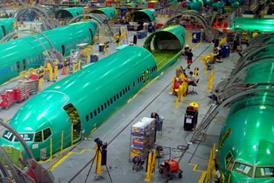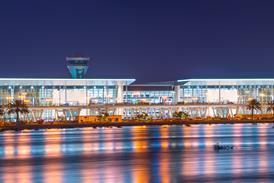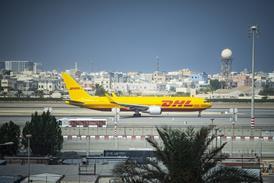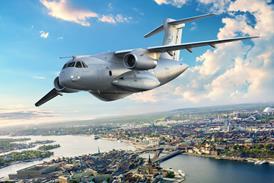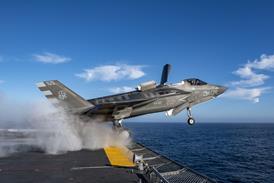Europe's plan to include aviation in its Emissions Trading Scheme has drawn a hail of protest around the globe as carriers from outside the region shy away from paying the carbon fee. Airline Business editors gauge airline reaction from around the globe
The European view
"For us, the issue is how green can you come before turning red?" says Ulrich Schulte-Strathaus, secretary general of the Association of European Airlines (AEA). In principle the AEA is in favour of airlines being included in emissions trading in 2011, but says it must not be so expensive that it kills the industry.
"It has to be a workable and affordable trading scheme, one that does not distort competition with other regions and one that delivers on the green objectives," says Schulte-Strathaus. "If all these requirements are met it is the way we should proceed."
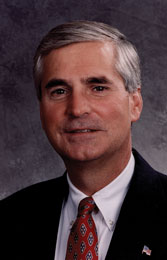 |
|---|
| "Europe is free to enter into any emissions trading that would be helpful" John Meenan, chief operating officer, Air Transport Association or America. |
As the airline body closest to, and most affected by, the Emissions Trading Scheme (ETS), the AEA has been sweating over its ramifications longer than any. It faces a pan-governmental body in the European Commission (EC) that is determined to address climate change, a strong regional green lobby and a public perception that aviation is a high-profile polluter and one that is getting worst.
The pressure is on European airlines to get behind the ETS. "We want to support the EC in its efforts to convince the public they can take to the skies with a clear conscience," says Schulte-Strathaus. The AEA understands it is not good enough simply to point the finger at other more-polluting industries and ask why aren't they doing more?
"At the broad level AEA members have a track record for environmentally responsible behaviour and for long before Kyoto has been implementing measures to reduce its impact on aviation," he says. AEA has supported research into alternative fuels and promoted measures to impact air traffic management.
However, as long as aviation remains a growth industry, such measures will not be enough to curb its impact on climate change. "The AEA acknowledges aviation will have to be carbon neutral and that the way to do this is to include aviation in the ETS," says Schulte-Strathaus.
Europe's ETS proposals as they stand today are better than originally drafted, with several "highly contentious elements withdrawn", says Schulte-Strathaus. For instance, the proposal has postponed by a year the controversial inclusion of flights between the European Union and the rest of the world.
The AEA is now starting an impact assessment "so we have a clear idea of the economic, political and financial consequences", says Schulte-Strathaus. Emissions trading must also be part of a package of measures, including infrastructure improvements, he says.
Europe's ETS proposal
On 20 December last year the European Commission proposed legislation to bring greenhouse gases from civil aviation into the European Union Emissions Trading Scheme (ETS).
The proposed directive will cover emissions from flights within the European Union (EU) from 2011 and all flights to and from EU airports from 2012. Both EU and foreign aircraft operators would be covered.
The total number of allowances available will be capped at the average level in 2004-6. Some will be auctioned, but the overwhelming majority will be issued free on the basis of a harmonised efficiency benchmark reflecting each operator's historical share of traffic.
As with the industrial companies already covered by the EU ETS, airlines will be able to sell surplus allowances if they reduce emissions and will need to buy additional allowances if their emissions grow.
To reduce administration costs, very light aircraft will not be covered by the scheme and each operator will be administered by just one member state.
The US view
US airlines and government have protested more vehemently than any other region against Europe's trading plan. They object to not being consulted about the ETS, would prefer what is a global problem to be tackled at the world level through ICAO, and are threatening legal action if the EC tries to impose carbon trading on US carriers.
"There are better ways to approach the whole issue," says John Meenan, chief operating officer of the Air Transport Association of America (ATA). "It is the antithesis of a global solution to what is a global problem," says John Byerly, US State Department deputy assistant secretary for transportation affairs.
The environment has been in the "top five" issues on the ATA's agenda for the past two years, with US carriers highly engaged at ICAO level on these issues for over a decade, explains Meenan. However, ATA believes the fuel efficiency efforts the industry continues to make through technological improvements, coupled with the modernisation of air traffic management systems, is where efforts should be concentrated. "Since 2000 the industry has seen a 37% improvement in how many passengers can be moved by a gallon of fuel," says Meenan.
Emissions trading is simply not on the US radar screen. "We have sympathy with the pressure they are facing in Europe, and they are free to enter into any emissions trading that would be helpful to address their issues," says Meenan.
But any attempt to bring US carriers into the scheme would, in the ATA's view, most likely violate international law, says Meenan. Europe "can do what it wants with its own carriers [but the wider plan] is permissible only on the basis of mutual consent of the relevant foreign governments", says Byerly.
The ATA has not conducted any formal estimate into the potential cost to its members, but it would be a "very expensive proposition", running into billions of dollars, says Meenan. He reacts angrily to suggestions, made by some in Europe, that the US position is irresponsible. "I don't think we need to feel contrite frankly - we have done a remarkable job," he says, with aviation doing a lot more than other industry sectors. "I would put our record up against just about anybody's out there."
The low-cost view
The European Low Fares Airline Association (ELFAA) supports the inclusion of aviation in the Emissions Trading Scheme, but wants all operators to be included from the start. "It is unfair and discriminatory that long-haul airlines, who are the biggest polluters, would not have to pay the cost of their emissions," says its secretary general John Hanlon.
Ryanair chief executive Michael O'Leary is sceptical that the ETS will reduce the impact of aviation on the environment. "The airlines are not the cause of the problem," he says. "China opening 100 power stations per year will cause a far greater problem." He also believes Europe should not go it alone. "The world should jump first. Let's get the Americans, the Russians and the Asians to agree to something first," he says.
EasyJet too wants the ETS to apply to all carriers: "The EU must discourage airlines from flying old, half-empty aircraft and must prevent non-EU airlines from getting a free ride."
What is carbon trading?
Emissions trading is an administrative approach to controlling pollution by providing economic incentives for reducing the emission of greenhouse gases.
The European Commission (EC) has set a limit on the amount of carbon dioxide (CO2) that can be emitted. Companies or other groups that emit CO2 are given credits or allowances that represent the right to emit a specific amount.
The total amount of credits cannot exceed the cap, limiting total emissions to that level. Companies that pollute beyond their allowances must buy credits from those that pollute beneath their limits. In effect, the buyer is being fined for polluting, while the seller is being rewarded for having reduced emissions. The proposal is for aviation to join the EC's existing ETS, which began in 2005.
The Asian view
In the Asia-Pacific, the issue of aircraft emissions is way down the order of big regional environmental challenges. When emissions are brought up "people look at you with raised eyebrows, it is seen as a tiny part of the overall problem," says Andrew Herdman, director general of the Association of Asia Pacific Airlines (AAPA).
Green issues are high on the political agenda in the region, but the big ticket issues for the region at large are air and water quality and industrial effluents. This is part of the reason why AAPA has come down hard against what it says is the European Commission's (EC) "unilateral" and "premature" approach to including aviation in its Emissions Trading Scheme (ETS). "It is gesture politics rather than addressing the global issue of climate change," says Herdman.
He says it is "regrettable" the lack of consultation with non-European Union states about the ETS. The AAPA tried to engage with the EC, but was rebuffed, he says. It will keep trying.
The AAPA's opposition to the ETS does not mean the environment is unimportant to the region's carriers. "It has always been part of the work we do," says Herdman. The AAPA recently organised its first environment conference in Brunei to highlight its commitment to the subject.
Herdman is in concert with the US view that ICAO is the correct body to produce global environment standards. "The danger is that an approach outside ICAO could derail the process and lead to a protracted period of unresolved disputes," he says. "Europe would be well advised to introduce it as an intra-EU scheme only."
While the AAPA has deep reservations about the EU's approach, it is not against the principle of emissions trading. But, according to Herdman: "It is naïve to think that emissions trading or taxes will work by curbing demand - the evidence is that they won't be effective. The question is will the funds raised be put to good use in achieving reductions in emissions elsewhere?"
The region is taking the issue seriously. "It would be a mistake to see it as a small, local, political difficulty in Europe," says Herdman. This might have been true a year or two ago, but not any more for Asia-Pacific airlines.
The Arab view
The Arab Air Carriers Association (AACO) is watching Europe's developments with intense interest as it waits to discover the full details of the proposed Emissions Trading Scheme.
AACO will meet representatives from the European Commission in February to learn what is proposed, and how any move to extend the scheme to all carriers entering, leaving or transiting through Europe would affect its members, says Mouna Moussi, AACO's executive director - industry affairs. She stresses that its members have young, fuel-efficient fleets and that air traffic delays are much less of an issue for the region than in more congested parts of the world.
"Aviation is constantly being hammered with rules and regulations. This needs to be balanced with the economic and social benefits it brings," Moussi says. "There are other challenges in the region that need to be dealt with and they are not all related to the sky."
The African view
African carriers do not generally have the environment high on their agenda, arguing that the continent accounts for only 3.5% of the world's air transport, has a vast area and a sparse population. However, Girma Wake, chief executive of Ethiopian Airlines, sounds a warning: "We have to think about it, if it hits us, we have little protection."
Latin American view
The Latin American Airline Association (ALTA) believes that, like other global issues, the right place to consider emissions trading is through ICAO. "ALTA considers that the problem should be studied on a global basis, without imposing unilateral actions, and finding ways to protect the environment without affecting unnecessarily the airline industry," says Alex de Gunten, its executive director.
Cost of carbon trading diagramSource: Airline Business

